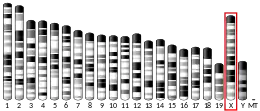Glypican-4 is a protein that in humans is encoded by the GPC4 gene.[5][6]
Cell surface heparan sulfate proteoglycans are composed of a membrane-associated protein core substituted with a variable number of heparan sulfate chains. Members of the glypican-related integral membrane proteoglycan family (GRIPS) contain a core protein anchored to the cytoplasmic membrane via a glycosyl phosphatidylinositol linkage. These proteins may play a role in the control of cell division and growth regulation. The GPC4 gene is adjacent to the 3' end of GPC3 and may also play a role in Simpson-Golabi-Behmel syndrome.[6]
See also
References
- 1 2 3 GRCh38: Ensembl release 89: ENSG00000076716 - Ensembl, May 2017
- 1 2 3 GRCm38: Ensembl release 89: ENSMUSG00000031119 - Ensembl, May 2017
- ↑ "Human PubMed Reference:". National Center for Biotechnology Information, U.S. National Library of Medicine.
- ↑ "Mouse PubMed Reference:". National Center for Biotechnology Information, U.S. National Library of Medicine.
- ↑ Veugelers M, Vermeesch J, Watanabe K, Yamaguchi Y, Marynen P, David G (October 1998). "GPC4, the gene for human K-glypican, flanks GPC3 on xq26: deletion of the GPC3-GPC4 gene cluster in one family with Simpson-Golabi-Behmel syndrome". Genomics. 53 (1): 1–11. doi:10.1006/geno.1998.5465. PMID 9787072.
- 1 2 "Entrez Gene: GPC4 glypican 4".
Further reading
- Sheu TJ, Schwarz EM, O'Keefe RJ, Rosier RN, Puzas JE (May 2002). "Use of a phage display technique to identify potential osteoblast binding sites within osteoclast lacunae". Journal of Bone and Mineral Research. 17 (5): 915–22. doi:10.1359/jbmr.2002.17.5.915. PMID 12009023.
- Karumanchi SA, Jha V, Ramchandran R, Karihaloo A, Tsiokas L, Chan B, Dhanabal M, Hanai JI, Venkataraman G, Shriver Z, Keiser N, Kalluri R, Zeng H, Mukhopadhyay D, Chen RL, Lander AD, Hagihara K, Yamaguchi Y, Sasisekharan R, Cantley L, Sukhatme VP (April 2001). "Cell surface glypicans are low-affinity endostatin receptors" (PDF). Molecular Cell. 7 (4): 811–22. doi:10.1016/S1097-2765(01)00225-8. PMID 11336704. S2CID 43358048.
- Hagihara K, Watanabe K, Chun J, Yamaguchi Y (November 2000). "Glypican-4 is an FGF2-binding heparan sulfate proteoglycan expressed in neural precursor cells". Developmental Dynamics. 219 (3): 353–67. doi:10.1002/1097-0177(2000)9999:9999<::AID-DVDY1059>3.0.CO;2-#. PMID 11066092. S2CID 42594598.
- Veugelers M, Cat BD, Muyldermans SY, Reekmans G, Delande N, Frints S, Legius E, Fryns JP, Schrander-Stumpel C, Weidle B, Magdalena N, David G (May 2000). "Mutational analysis of the GPC3/GPC4 glypican gene cluster on Xq26 in patients with Simpson-Golabi-Behmel syndrome: identification of loss-of-function mutations in the GPC3 gene". Human Molecular Genetics. 9 (9): 1321–8. doi:10.1093/hmg/9.9.1321. PMID 10814714.
- Siebertz B, Stöcker G, Drzeniek Z, Handt S, Just U, Haubeck HD (December 1999). "Expression of glypican-4 in haematopoietic-progenitor and bone-marrow-stromal cells". The Biochemical Journal. 344. 344 Pt 3 (3): 937–43. doi:10.1042/bj3440937. PMC 1220719. PMID 10585884.
- Huber R, Mazzarella R, Chen CN, Chen E, Ireland M, Lindsay S, Pilia G, Crisponi L (December 1998). "Glypican 3 and glypican 4 are juxtaposed in Xq26.1". Gene. 225 (1–2): 9–16. doi:10.1016/S0378-1119(98)00549-6. PMID 9931407.
- Watanabe K, Yamada H, Yamaguchi Y (September 1995). "K-glypican: a novel GPI-anchored heparan sulfate proteoglycan that is highly expressed in developing brain and kidney". The Journal of Cell Biology. 130 (5): 1207–18. doi:10.1083/jcb.130.5.1207. PMC 2120559. PMID 7657705.
External links
This article is issued from Wikipedia. The text is licensed under Creative Commons - Attribution - Sharealike. Additional terms may apply for the media files.





